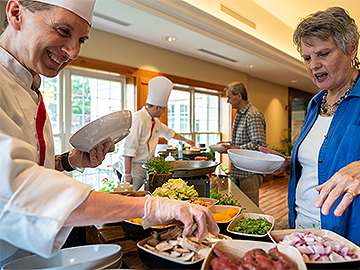For many seniors, moving into a senior living community can be both daunting and exciting. They’re leaving the homes, routines, and traditions that are woven into the fabric of their being, and they’ll no longer see the familiar faces of people they know and love on a daily basis. In addition, they’re relocating to new surroundings where there may be at least 100 other residents and dozens of staff members they haven’t met but would like to. So how can senior living providers ease the transition from home to senior living community and provide opportunities for residents to meet people and make new friends? Great food and hospitality.
Food is the ultimate conduit through which connections are made, friendships are formed, and memories are created. It provides comfort, nostalgia and familiarity while promoting interaction and great conversation. Food is the consummate reason to sit face-to-face and converse. Dining together at a table creates opportunities for people to learn about each other: their preferences, their opinions and their experiences.
Corey Wilsey, Sodexo Seniors’ vice president of North American operations, says:
“Every great experience in life is based around food. I think this is true regardless of your age.”
Food Generates Comfort

In senior living communities, food can also serve as a way to put residents at ease by finding out which meals bring them comfort and remind them of home. Serving foods that are intertwined with residents’ special memories makes them feel relaxed and perhaps more talkative, freeing them to share fond memories with other residents and perhaps staff. “The ability to connect residents back to those moments that they had in their lives is powerful,” Wilsey says. “It’s important for us to ask residents which foods bring them joy and comfort and try to reinvent them and put them in our menus. When you use food as a connector, you embed Sodexo with that resident, their family and the client for a long time.”
Another good way to create connections among residents is by making them feel that certain meals were prepared especially for them. Live food prep stations allow residents to meet the chefs and tell them how they want their food prepared. It gives the impression that each resident has a personal chef that prepares a meal just for them. “The live food prep stations get the most foot traffic. Whether we’re making pizzas, pasta or tacos, residents love it,” Wilsey says. “That personal relationship that they have with their chef is so important. It provides a greater sense of connection.”
Evolving to Create New Connections
Lastly, dining services and menus in senior living communities should evolve to accommodate the preferences of new generations of seniors as they move in. “As a newer generation of seniors transitions to senior living, more menu options are needed to accommodate that group. Baby boomers like to go out to eat, and now they’re moving into senior living communities,” Wilsey says. “They’re demanding restaurant experiences and most current senior living models don’t really meet that expectation.”
Food nourishes, revives, and connects people to their past, present and future. From beverages and snacks to entrees and desserts, each meal is an opportunity to recall memories, connect with others and share thoughts and ideas. Connection is important at any age, but it takes on special meaning as people get older, and one of the best ways to create connections among seniors is good food and hospitality.
